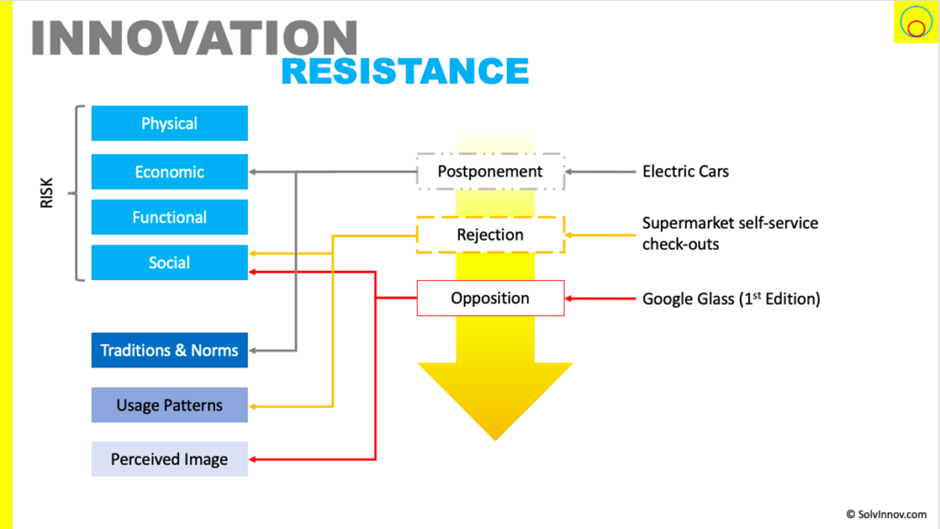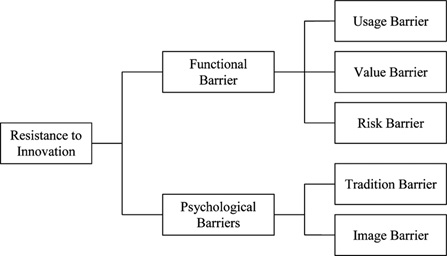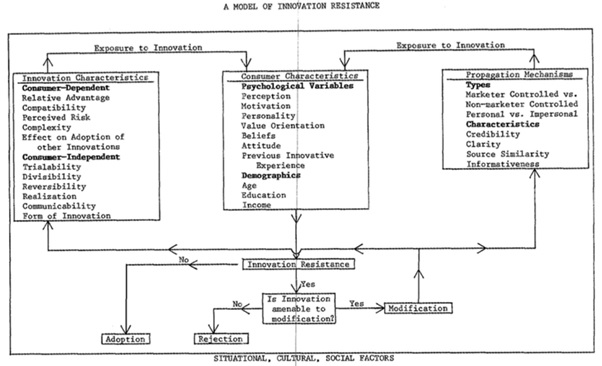Innovation Resistance Theory

Innovation Resistance Theory
Acronym
IRT
Alternate name(s)
N/A
Main dependent construct(s)/factor(s)
New IS implementation facing ‘rejection’ or ‘opposition’ or atleast resulting in ‘postponement’
Main independent construct(s)/factor(s)
Functional (Situational), Psychological (Cultural, Social) barrier factors causing hesitancy to implementation of new IS technologies
Concise description of theory
IRT – Innovation resistance theory is a concept that describes the phenomenon of resistance to change and the adoption of new ideas and technologies. It seeks to understand why individuals, organizations, and societies may be hesitant to embrace new innovations and the factors that influence their willingness to adopt new technologies. Innovation resistance theory identifies several key factors that contribute to resistance to change, including:
- Perceived threat to existing structures and norms: new innovations may challenge existing structures and norms, which can lead to resistance from individuals and organizations who are invested in maintaining the status quo.
- Lack of understanding or familiarity: The unfamiliarity of a new innovation can cause individuals and organizations to be wary of embracing it, as they may not fully understand how it works or how it will impact their lives and work.
- Perceived risks and uncertainty: The uncertainty and potential risks associated with new innovations can cause individuals and organizations to be cautious about embracing them.
- Lack of perceived benefits: If individuals and organizations do not see the benefits of a new innovation, they may be less likely to adopt it.
- Economic and organizational factors: Economic and organizational factors, such as costs and resource constraints, can also play a role in shaping an organization's willingness to adopt new innovations.
Generic context
Innovation resistance theory provides a useful framework for understanding the factors that contribute to resistance to change and can help organizations and individuals overcome these barriers and adopt new innovations. By understanding the root causes of resistance to change, organizations can develop strategies to promote the adoption of new technologies and innovations.
In simple words, Innovation Resistance Theory is a way of understanding THE BARRIERS about why some people don’t like or resist new things or new ways of doing things. Here is a scenario that shows how barriers can affect someone’s decision to buy a new thing: imagine as a kid, you are at the store with your mom and you see a cool toy robot that can talk and dance. You (as a kid) really want your mom to buy it for you, but she says no. She might have different reasons for saying no, such as:
- Usage barrier: She thinks it’s too complicated for you to use as a kid.
- Value barrier: She doesn’t think the robot is useful or fun enough for its price.
- Risk barrier: She worries that the robot might break easily or hurt you somehow.
- Tradition barrier: She prefers simpler toys that she played with when she was young.
- Image barrier: She thinks the robot is too flashy or childish for you.
‘Information Systems’ context
The relevance lies in the fact that IS often involves the adoption and implementation of new technologies, which can be met with resistance from individuals and organizations. Understanding the underlying causes of innovation resistance can help organizations and individuals overcome these barriers and more effectively adopt and implement new IS technologies.
Here are some ways in which innovation resistance theory is relevant to IS:
- Overcoming resistance to change: By understanding the factors that contribute to innovation resistance, organizations can develop strategies to overcome these barriers and promote the adoption and implementation of new IS technologies.
- Improving IS adoption: By understanding the factors that influence individuals' and organizations' willingness to adopt new IS technologies, organizations can develop programs and initiatives to improve adoption and reduce resistance to change.
- Promoting IS innovation: By understanding the root causes of innovation resistance, organizations can identify opportunities to promote and facilitate IS innovation, leading to more effective and efficient use of technology.
- Improving IS implementation: Understanding the factors that contribute to innovation resistance can help organizations more effectively implement new IS technologies, reducing the likelihood of resistance and improving overall outcomes.
In conclusion, innovation resistance theory is highly relevant to IS, as it provides valuable insights into the factors that contribute to resistance to change and the adoption of new technologies. By understanding these factors, organizations can more effectively adopt and implement new IS technologies and overcome resistance to change.
Diagram/schematic of theory
- Figure 1: Schematic diagram of Innovation Resistance (Source: Solvinnov - an external link website by Dr Adam Tracy)
- Figure 2: Types of Invocation Resistance (Source: Ram, S. and Sheth, J.N. 1989)
- Figure 3: Model of Innovation Resistance (Source: Ram, 1987, p. 209)
.
.
Originating author(s)
- Sheth, Jagadish. N; & Stellner, W. H. (1979) – provided the psychology base thought process
- S. Ram (1987) – conceptualized a model of Innovation Resistance
- Ram, S. and Sheth, J.N. (1989) – refined the model explanation from practical perspective
Seminal article(s)
- Sheth, J. N; & Stellner, W. H. (1979). Psychology of Innovation Resistance: The less developed concept (LDC) in diffusion research (No. 622). Urbana-Champaign, IL, USA: College of Commerce and Business Administration, University of Illinois at Urbana-Champaign. Permalink: https://hdl.handle.net/2142/26627
- S. Ram (1987), A Model of Innovation Resistance, in NA - Advances in Consumer Research Volume 14, eds. Melanie Wallendorf and Paul Anderson, Provo, UT: Association for Consumer Research, Pages: 208-212. https://www.acrwebsite.org/volumes/6688/volumes/v14/NA-14
- Ram, S. and Sheth, J.N. (1989), Consumer Resistance to Innovations: The Marketing Problem and its solutions, Journal of Consumer Marketing, Vol. 6 No. 2, pp. 5-14. https://doi.org/10.1108/EUM0000000002542
Originating area
Marketing – Consumer Behaviour
Level of analysis
Group
Links from this theory to other theories
This theory is different from ‘Diffusion of Innovations Theory’, which is also a popular innovation-based theory used in context of IS – Information Systems
Key References Outside IS Research Area
- Isabelle Szmigin, Gordon Foxall (1998), Three forms of innovation resistance: the case of retail payment methods, Technovation, Volume 18, Issues 6–7, Pages 459-468, ISSN 0166-4972, https://doi.org/10.1016/S0166-4972(98)00030-3
- Artem Dibrov (2015), Innovation Resistance: The Main Factors and Ways to Overcome Them, n Procedia - Social and Behavioral Sciences, Volume 166, Pages 92-96, ISSN 1877-0428, https://doi.org/10.1016/j.sbspro.2014.12.489
- Heidenreich, S. and Kraemer, T. (2016), Innovations—Doomed to Fail? Journal of Product Innovation Management, Vol 33: Pages 277-297. https://doi.org/10.1111/jpim.12273
- Ju, N., Lee, KH. (2020), Consumer resistance to innovation: smart clothing (Fashion and Textiles), International Journal of Interdisciplinary Research, Volume 7, 21. https://doi.org/10.1186/s40691-020-00210-z
- Mohd Sadiq, Mohd Adil, Justin Paul (2021), An innovation resistance theory perspective on purchase of eco-friendly cosmetics, Journal of Retailing and Consumer Services, Volume 59, 102369, ISSN 0969-6989, https://doi.org/10.1016/j.jretconser.2020.102369
- Dan Huang, Alexandra Coghlan, Xin Jin (2022), A process perspective on consumer innovation resistance to Airbnb: A narrative approach, International Journal of Hospitality Management, Volume 107, 103306, ISSN 0278-4319, https://doi.org/10.1016/j.ijhm.2022.103306
- Xiu-Ming Loh, Voon-Hsien Lee, Lai-Ying Leong, Eugene Cheng-Xi Aw, Tat-Huei Cham, Yun-Chia Tang, Jun-Jie Hew (2023), Understanding consumers’ resistance to pay with cryptocurrency in the sharing economy: A hybrid SEM-fsQCA approach, Journal of Business Research, Volume 159, 113726, ISSN 0148-2963, https://doi.org/10.1016/j.jbusres.2023.113726
IS articles that use the theory
- T. Laukkanen (2015), How Uncertainty Avoidance Affects Innovation Resistance in Mobile Banking: The Moderating Role of Age and Gender, 48th Hawaii International Conference on System Sciences, Kauai, HI, USA, 2015, pp. 3601-3610, https://doi.org/10.1109/HICSS.2015.433
- Ma, L., & Lee, C. S. (2019). Understanding the Barriers to the Use of MOOCs in a Developing Country: An Innovation Resistance Perspective. Journal of Educational Computing Research, 57(3), 571–590. https://doi.org/10.1177/0735633118757732
- Kaur P; Dhir A; Singh N; Sahu G; Almotairi M; (2020), An innovation resistance theory perspective on mobile payment solutions, in Journal of Retailing and Consumer Services, Volume 55, 102059, ISSN 0969-6989, https://doi.org/10.1016/j.jretconser.2020.102059Three
- Chung, K. C., & Liang, S. W. J. (2020). Understanding factors affecting innovation resistance of mobile payments in Taiwan: An integrative perspective. Mathematics, 8(10), 1841. https://doi.org/10.3390/math8101841
- Kaur, P; Dhir, A; Ray, A; Bala, P.K; and Khalil, A. (2021), Innovation resistance theory perspective on the use of food delivery applications, Journal of Enterprise Information Management, Vol. 34 No. 6, pp. 1746-1768. https://doi.org/10.1108/JEIM-03-2020-0091
- Zhenya Tang, Leida Chen (2022); Understanding seller resistance to digital device recycling platform: An innovation resistance perspective, Electronic Commerce Research and Applications, Volume 51, 101114, ISSN 1567-4223, https://doi.org/10.1016/j.elerap.2021.101114
- Shishan, F., Hmoud, H., Zaidan, H., Qasem, Z. (2022). The Innovation Resistance Theory: The Case of Cryptocurrencies. In: Musleh Al-Sartawi, A.M.A. (eds) Artificial Intelligence for Sustainable Finance and Sustainable Technology. ICGER 2021. Lecture Notes in Networks and Systems, vol 423. Springer, Cham. https://doi.org/10.1007/978-3-030-93464-4_45
- Park, E. H., Werder, K., Cao, L., & Ramesh, B. (2022). Why do Family Members Reject AI in Health Care? Competing Effects of Emotions. Journal of Management Information Systems, 39(3), 765–792. https://doi.org/10.1080/07421222.2022.2096550
External links
- https://solvinnov.com/resistance-of-innovation/ - a website maintained by Dr. Adam Tacy, dealing with various topics of innovation and has a dedicated section on IRT
- An exploratory study of mobile banking services resistance, July 2012, International Journal of Mobile Communications 10(4):366-385, https://doi/10.1504/IJMC.2012.048136 -- this doesn’t directly use the IRT theory but makes a good contextual reading on innovation resistance
- NADINE HIETSCHOLD, RONNY REINHARDT, SEBASTIAN GURTNER (2020), Who put the “NO” in Innovation? Innovation resistance leaders’ behaviour and self-identities, Technological Forecasting and Social Change, Volume 158, 120177, ISSN 0040-1625, https://doi.org/10.1016/j.techfore.2020.120177 -- this doesn’t directly use the IRT theory but makes a good contextual reading on innovation resistance
- https://hbsp.harvard.edu/product/W18034-PDF-ENG – Apple Watch: Managing Innovation Resistance, a teaching business case study by Tania Bucic, Gaganpreet Singh
- https://www.diva-portal.org/smash/get/diva2:865523/FULLTEXT01.pdf -- Attitudes of French consumers towards breakthrough innovation – A qualitative study about Google Glass, a 2015 Masters-degree-thesis by student authors Allison Le Garrec and Jérémy Torregrosa, under their Supervisor Peter Hultén, of college Umeå School of Business and Economics
- https://www.google.co.in/books/edition/Information_Systems_Innovation_and_Diffu/B2K9W5sqvKEC?hl=en&gbpv=0&kptab=overview – Google Books – Larsen, T. J. (1998). Innovation: A Framework for Research and Practice. Information systems innovation and diffusion: Issues and directions, 411.
Contributor(s)
Mukesh Chaware - scholar at Indian Institute of Management, Kozhikode, India
Date last updated
15-MAR-2023


